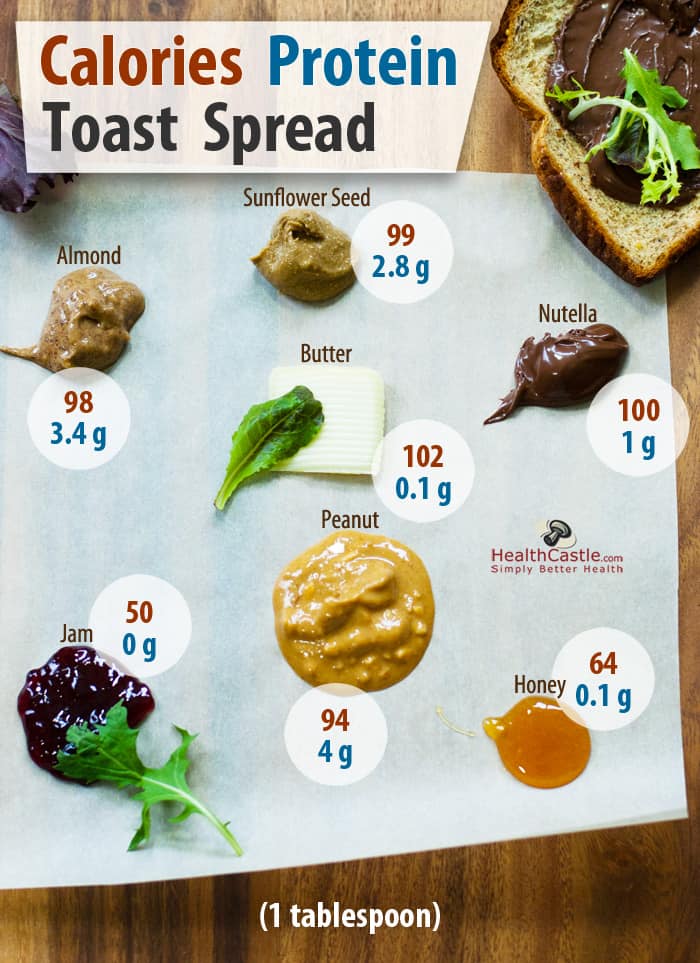
Written By: Gloria Tsang, RD
Title: Founding Registered Dietitian
Alumni: University of British Columbia
Last Updated on:

Not many people think of plain toast as a very fulfilling breakfast, so most of us dress it up with some kind of a spread. Which spread you use – and how much – can have a dramatic impact on how much nutrition (and protein, calories and sugar) you get out of your breakfast. Because spreads are to be put on toast (high in carbs), I always recommend choosing a spread offering protein for a better protein-carbohydrate pairing; it helps you feel full longer and delivers sustained energy! Here is a look at the nutritional facts of 9 popular spreads and how much protein and calories are in 1 tablespoon.

Not many spreads can boast peanut butter’s versatility. It provides a dose of carbohydrates for an energy boost, bundled with the full-feeling provided by protein and monounsaturated fat – a heart-healthy fat that lowers total cholesterol and LDL (“bad” cholesterol), while boosting HDL (“good” cholesterol). Peanut butter also contains Vitamin E, fiber, niacin, phosphorus, and magnesium. Everything I have just said now, only refers to natural peanut butter though. The main difference between “natural” and “not-so-natural” peanut butter. Natural peanut butter only contains peanuts and salt on its ingredient list. Processed peanut butter can contain a list of added ingredients, like sugar, palm oil, hydrogenated cottonseed oil, mono and diglycerides etc. In general, natural peanut butter offers higher amount of protein.
Nutritional Facts of Natural Peanut Butter (1 Tablespoon)
Boasting that it contains 50 hazelnuts per jar, Nutella is marketed as a healthy breakfast choice for children. But what the commercials don’t tell you is that Nutella has more sugar and palm oil than hazelnuts. Indeed, 40% of the calories come from sugar alone. It’s ok to enjoy this hazelnut-based chocolate spread once in a while as dessert; it’s just not a breakfast item to be eaten daily.
Nutritional Facts of Nutella (1 Tablespoon)
It’s very similar to peanut butter except for the nutty, almond butter taste. I love using almond butter in my bakery as its taste is relatively muted, compared to peanut butter. Most almond butter on the market is natural, meaning it’s just almonds and perhaps salt. However in recent years, there are more brands with added processed ingredients such as palm oil and sugar. Always read the ingredient list to be sure.
Nutritional Facts of Natural Almond Butter (1 Tablespoon)
Personally I prefer the taste of sunflower seed butter to almond butter on toast. But I have got to warn you, sunflower seed butter has a green tint which some might look odd (to children). On the flip side, it makes for an interesting talking point with kids. So far, I have only come across natural sunflower seed butter.
Nutritional Facts of Natural Sunflower Seed Butter (1 Tablespoon)
Our urge to eat more natural (and keto diet) has made butter a huge comeback! Yes butter is natural, but that doesn’t mean that it is appropriate for everyone to spread it on their toast every morning. If you have high triglycerides and cholesterol, speak to your doctor and dietitians on how much intake is appropriate for you. Butter virtually offers just calories and fat, and not needed protein.
Nutritional Facts of Natural Butter (1 Tablespoon)
The margarine category is now known as “spread”. When margarine was first introduced to the marketplace to replace butter’s saturated fat, it was loaded with trans fat. In recent years, since most countries have banned the use of artificial trans fat, food manufacturers created non-hydrogenated margarine, which contains no trans fat and much lower in fat than butter. Some margarine products have dairy added to create a creamy texture. Essentially, margarine products without dairy and other animal-origin additives may also be labelled as “vegan butter” nowadays. Margarine/spread is still a processed product; it may contain food additives, or other ingredients such as colorings. Read ingredient list carefully. As there are numerous margarine/spread brands in the market, we have chosen to list the nutrition facts of Country Crock (the best selling margarine brand in 2023 according to Statista).
Nutritional Facts of Country Crock Original (1 Tablespoon)
You may think of cream cheese as a good bagel companion which can boost your daily calcium intake. However, cream cheese is not a rich source for calcium, providing merely 14.1 mg of calcium per tablespoon. As there are various cream cheese products for different purposes, we chose to list the nutritional facts of spreadable cream cheese.
Nutritional Facts of Philadelphia Original Cream Cheese Spread (1 Tablespoon)
Jam or jelly can be a refreshing way to start your morning, but don’t fool yourself that you’re getting a serving of fruit. Most of the calories in many varieties of jam come from both natural and added sugar, sometimes with high fructose corn syrup. “Sugar-free” jams are often sweetened with artificial sweeteners, but still contain natural sugar from fruits. The main difference between jam and jelly, is that jam is often made with thickened pureed fruits, while jelly is made with thickened fruit juice. Ideally, look for jam or jelly made with its own natural puree or juice, without added sugar or artificial sweeteners. As there are various jam and preserves brands in the market, we’ve chosen to list the nutrition facts of Smucker’s (the most eaten jam brand in 2020 according to Statista).
Nutritional Facts of Smucker’s Pure Strawberry Jam (1 Tablespoon)
Spreading honey on toast is not restricted to the English any longer. Lately “honey toast” has been very popular in Japan and Taiwan. Primarily a dessert item, honey is drizzled on very thick toast. Often referred as the natural sweetener, honey does have additional nutrients and health properties. However, similar to jam, honey is also just sugar nutritionally.
Nutritional Facts of Honey (1 Tablespoon)
As I’ve said above, the ideal spread is the one that provides some protein. If possible, delivering a dose of healthy fats will be the cherry on top. Therefore I always go for the natural nut and seed butters, including peanut butter, almond butter, cashew butter, sunflower seed butter and more.
However, if you choose other kinds of spreads, the most important thing is to watch your portion sizes. One tablespoon is the standard. You can estimate a tablespoon by looking at your thumb. A serving size about the size of the tip of a woman’s thumb is 1 tablespoon. One tablespoon of any of these spreads is an okay way to start your day, but piling on extra spoonfuls can pack on extra sugar or calories fast.
Alumni: University of British Columbia – Gloria Tsang is the author of 6 books and the founder of HealthCastle.com, the largest online nutrition network run by registered dietitians. Her work has appeared in major national publications, and she is a regularly featured nutrition expert for media outlets across the country. The Huffington Post named her one of its Top 20 Nutrition Experts on Twitter. Gloria’s articles have appeared on various media such as Reuters, NBC & ABC affiliates, The Chicago Sun-Times, Reader’s Digest Canada, iVillage and USA Today.
almond butter, breakfast, butter, cream cheese, grocery aisle, honey, jam, margarine, nutella, nutrition facts, peanut butter, spread, sunflower seed butter, vegan butter
Why is Manuka honey so expensive?
Thanks for such helpful info! Until now I thought my “organic” peanut butter was as nutritional as my roommates “Natural” peanut butter.